Best beginner DJ controllers 2025: Top picks for budding mix masters
Entry-level devices for rekordbox, Serato, Traktor and more - perfect for beginner DJs
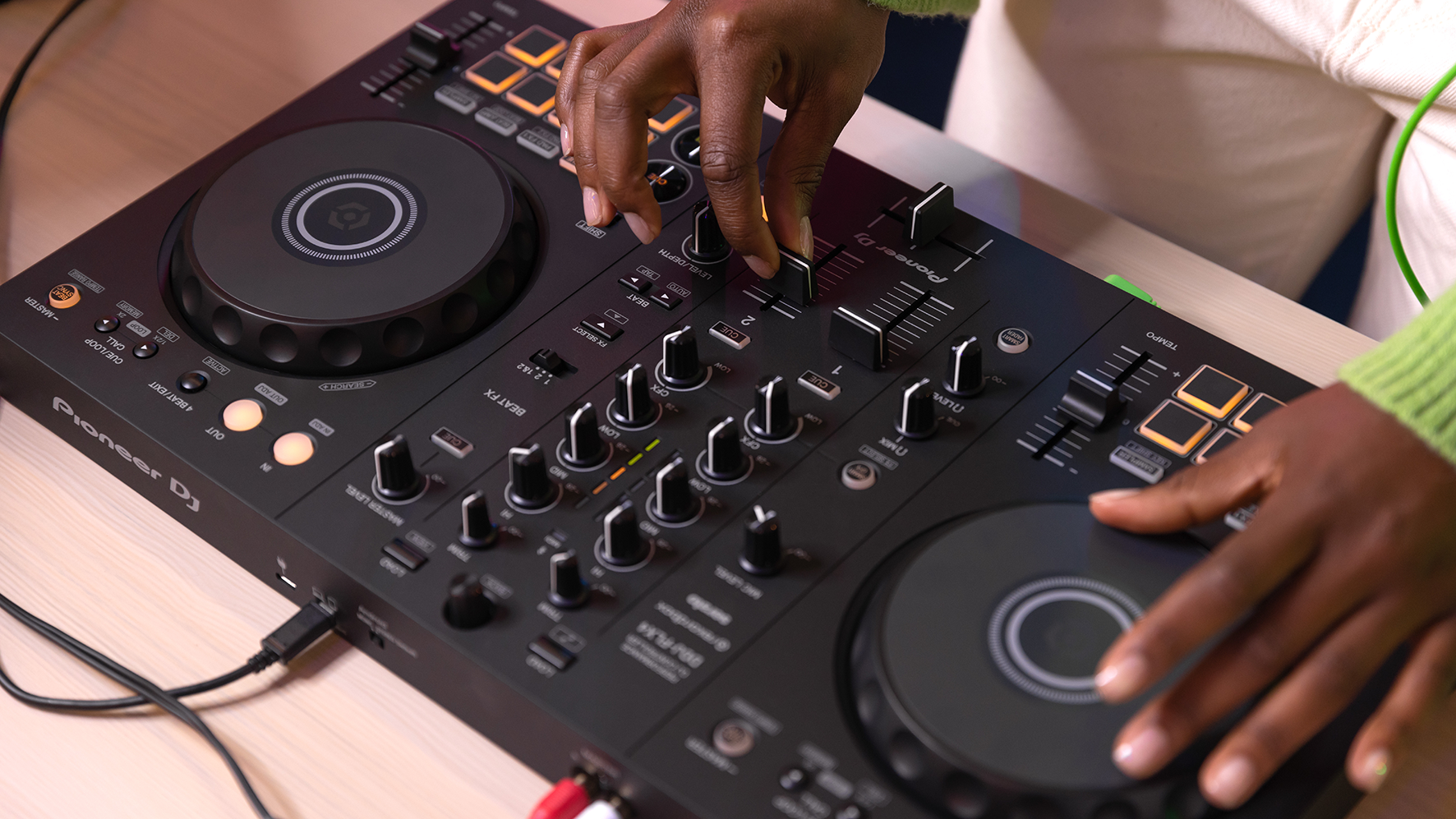
A DJ controller and computer combination is a great set-up for a DJ just starting out. It’s way cheaper than buying vinyl or dedicated digital decks, and while most controllers deliver substantial functionality, they’re also generally accessible in terms of learning how to use them. And while you can, in theory, learn to mix on your phone or just on your computer, using one of the best beginner DJ controllers is a great way to become familiar with the tactile experience you get in the wild while gigging.
However, the beginner DJ market is a diverse and sometimes overwhelming place, with numerous companies producing a range of units at various price points and with diverse function sets. Of course, this variety does give you the power to choose a model that best suits your particular DJing requirements, but it can be difficult to know where to start - well, that's where we come in.
First, all controllers run on software - Rekordbox, Serato, Tractor and DJuced are the main four - and some units will only work with certain programmes. You can test out the various DJing software for free or purchase it relatively cheaply prior to buying your controller to get a feel for what they offer.
Your style of DJing and the music you play are crucial factors in your buying decision. There are controllers with function sets explicitly aimed at different styles, such as scratch DJs or open-format DJs. Where you’ll use the controller also matters, as some are designed for gigging while others are more suitable for home use.
Our expert guide will take you through the current crop of controllers we’ve researched and tested to help you decide on which beginner DJ controller is best for you, as well as offer some useful buying advice, too.
Quick list
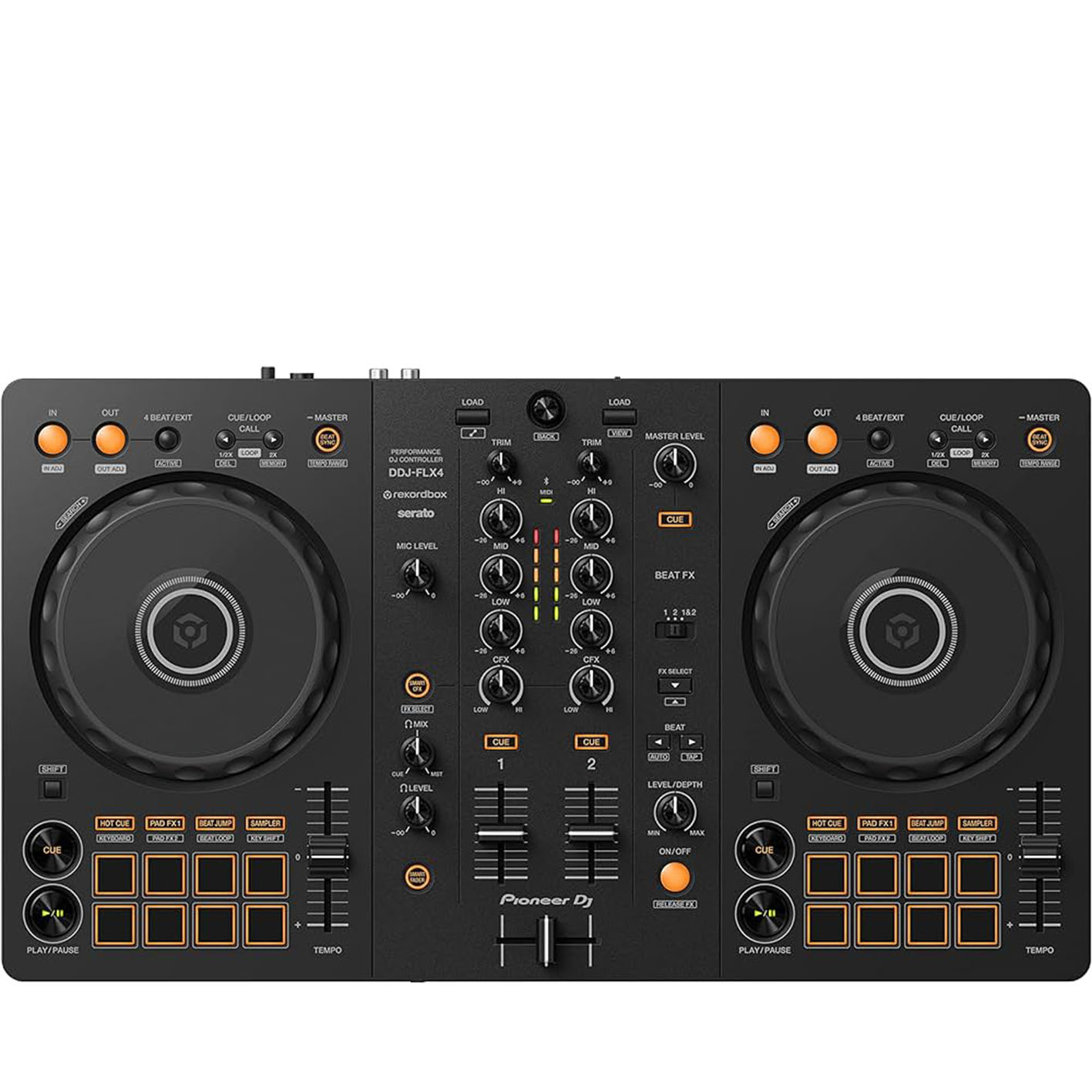
The 2-channel DDJ-FLX4 offers a simplified take on Pioneer's high-end options that delivers the essentials - jog wheels, performance pads and a simple mixer - without threatening to overwhelm beginner DJs with too steep a learning curve.
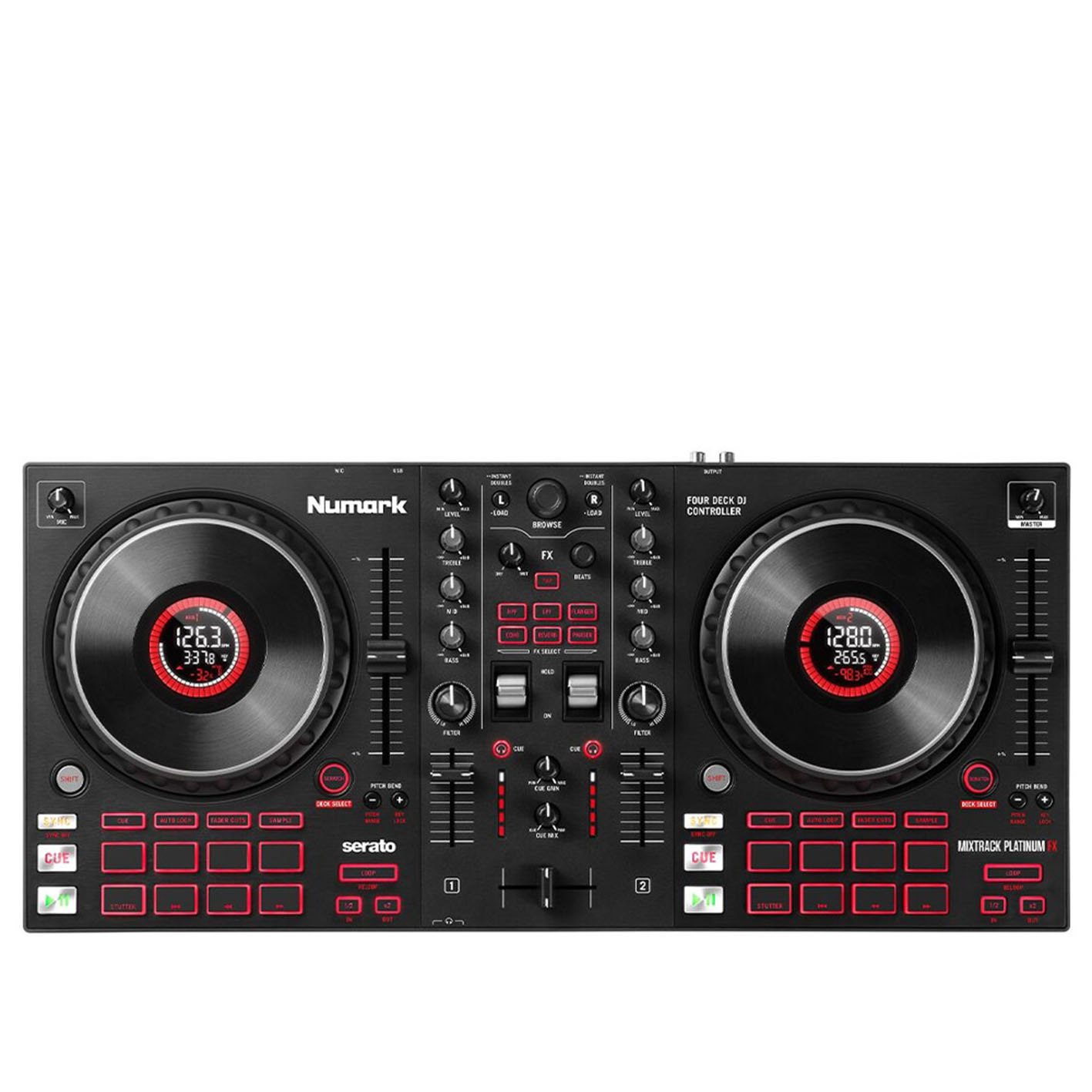
The Platinum FX is the top end Mixtrack controller, meaning it boasts pro features such as 4-deck mixing, sizeable jog wheels with hi-res displays and a mic input. The FX part of the name signifies the inclusion of a range of cool performance / remix tools such as Hot Cues, Auto Loop, Sampling and Fader Cuts.
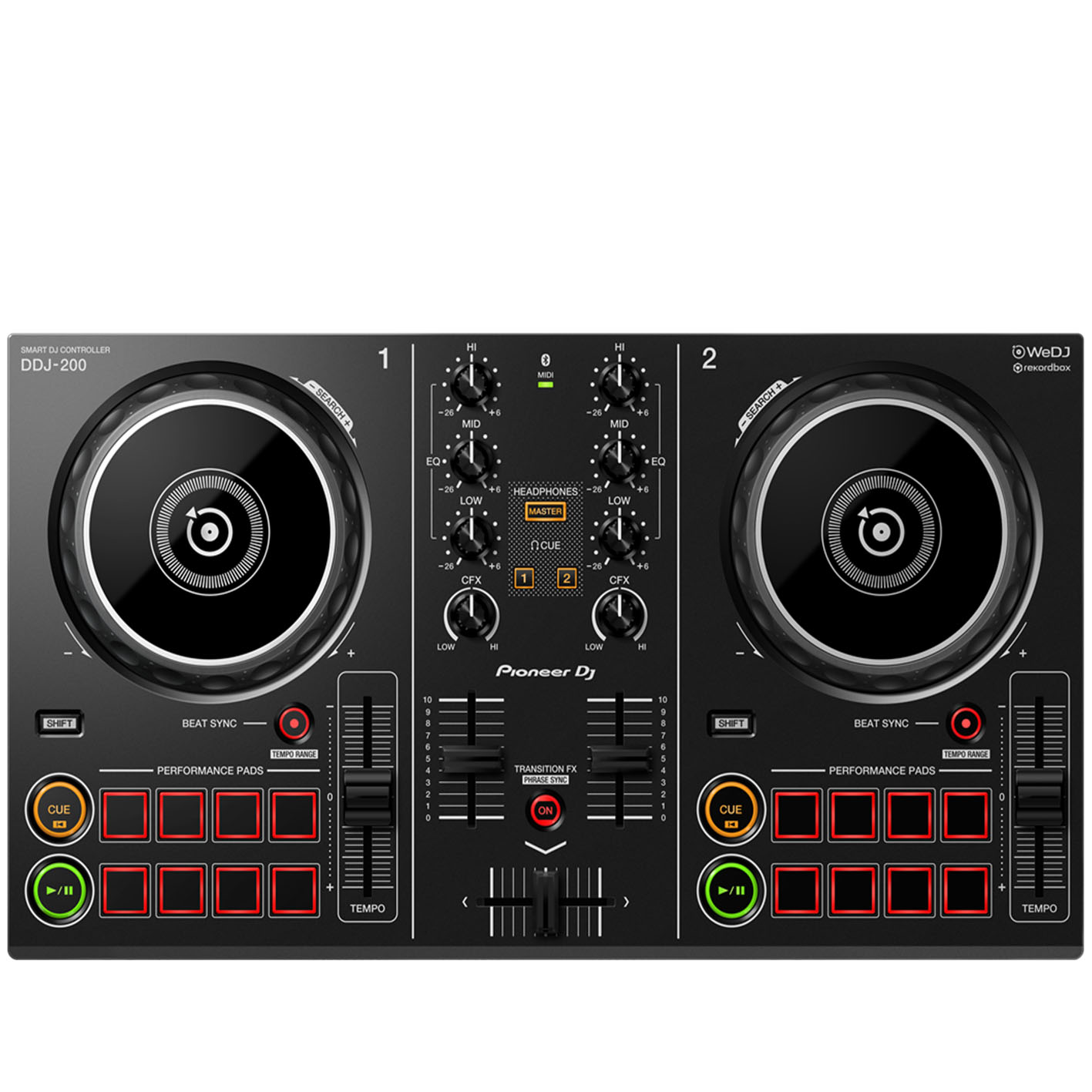
A smaller sibling to the DDJ-400, the DDJ-200 can be used with Algoriddim Djay, edjing Mix or Pioneer’s own rekordbox and WeDJ applications. The latter of these is an iOS/Android app with some great tutorial features aimed at getting newbies up to speed with the basics of DJing.
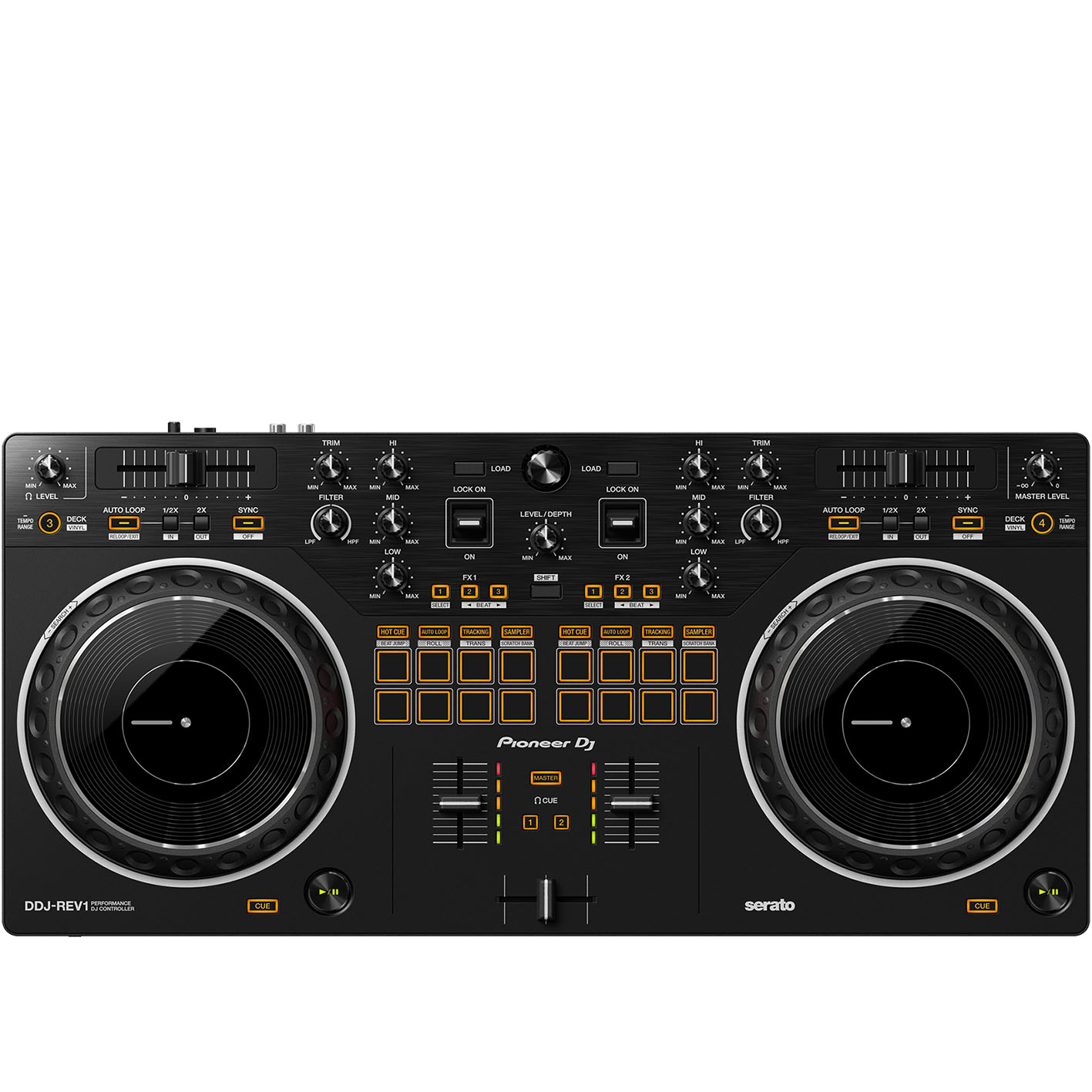
On the whole, scratch DJs and turntablists are fairly poorly served by entry-level DJ gear, which often features cheap crossfaders and small, unresponsive jogwheels. This affordable entry into Pioneer’s new DDJ Rev addresses that.
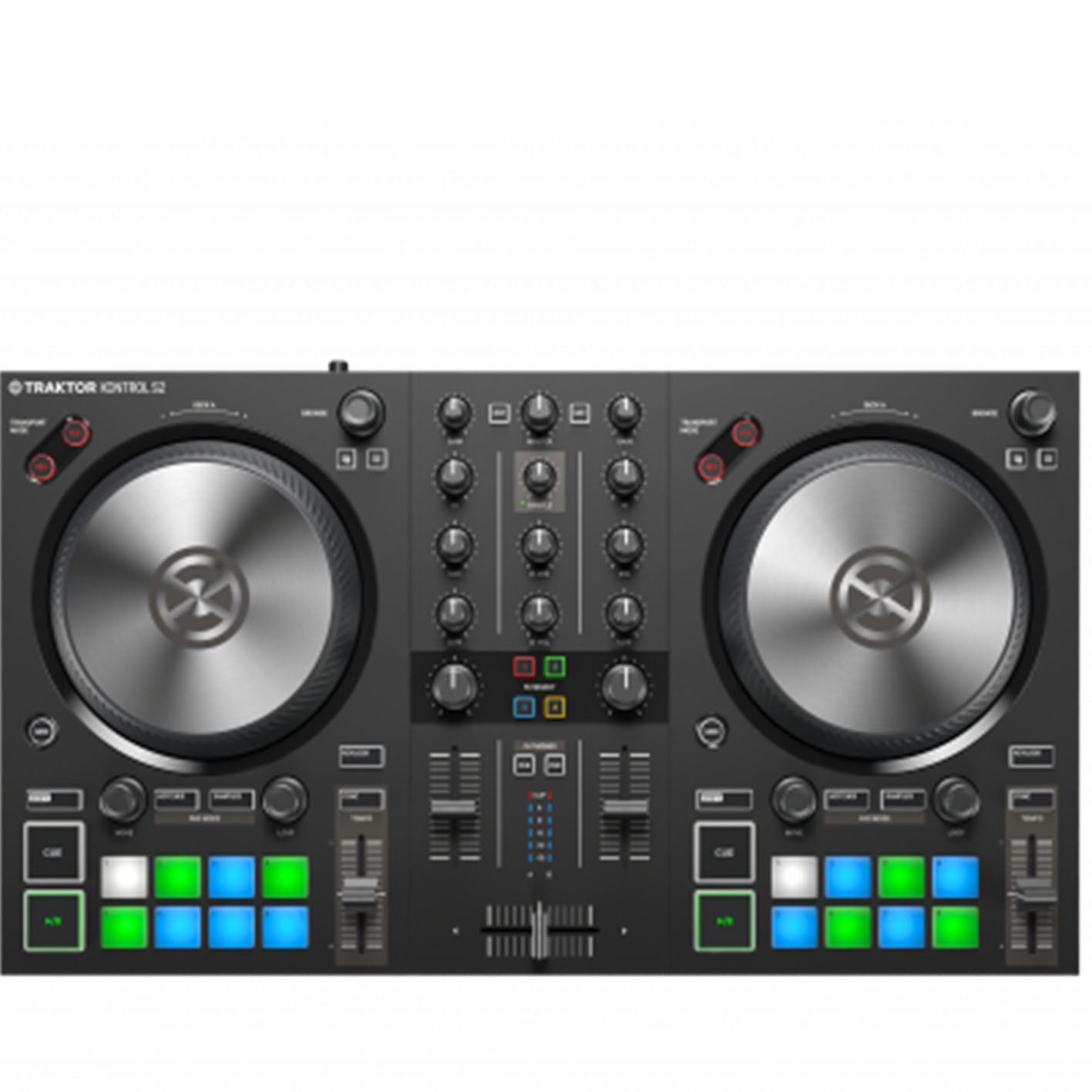
NI’s entry-level Traktor controller is one of the most stylish-looking devices you’ll find at this end of the market. It’s sturdily built too, and certainly feels more ‘pro’ than its price point suggests.
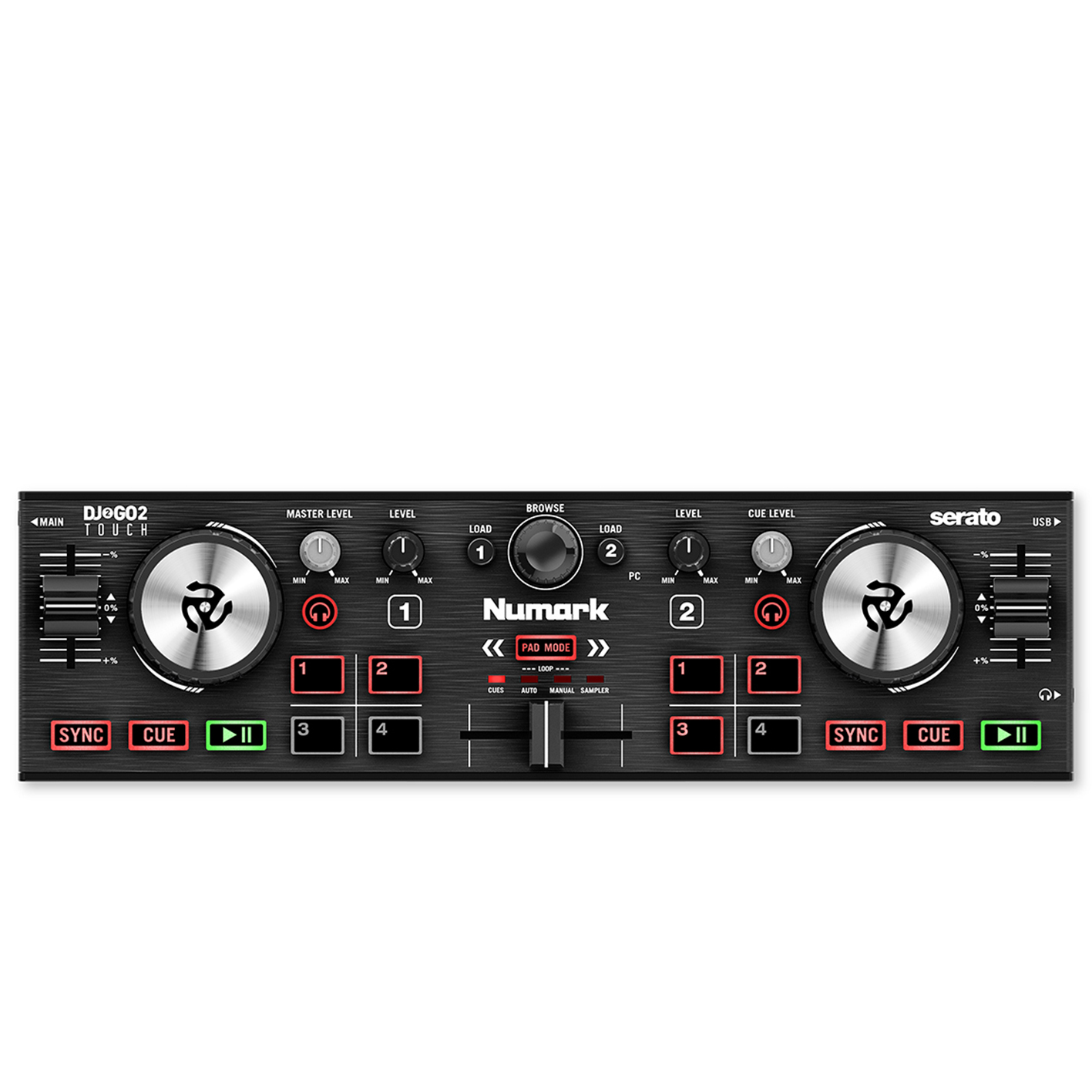
In terms of balancing size and features, Numark’s updated DJ2GO is one of the most jam-packed DJ controllers on the market. Its slim form factor could, just about, legitimately be called pocket-sized, but the device still finds space for two jog wheels, a crossfader, built-in interface and four performance pads for each deck.
Load the next 3 products... ↓
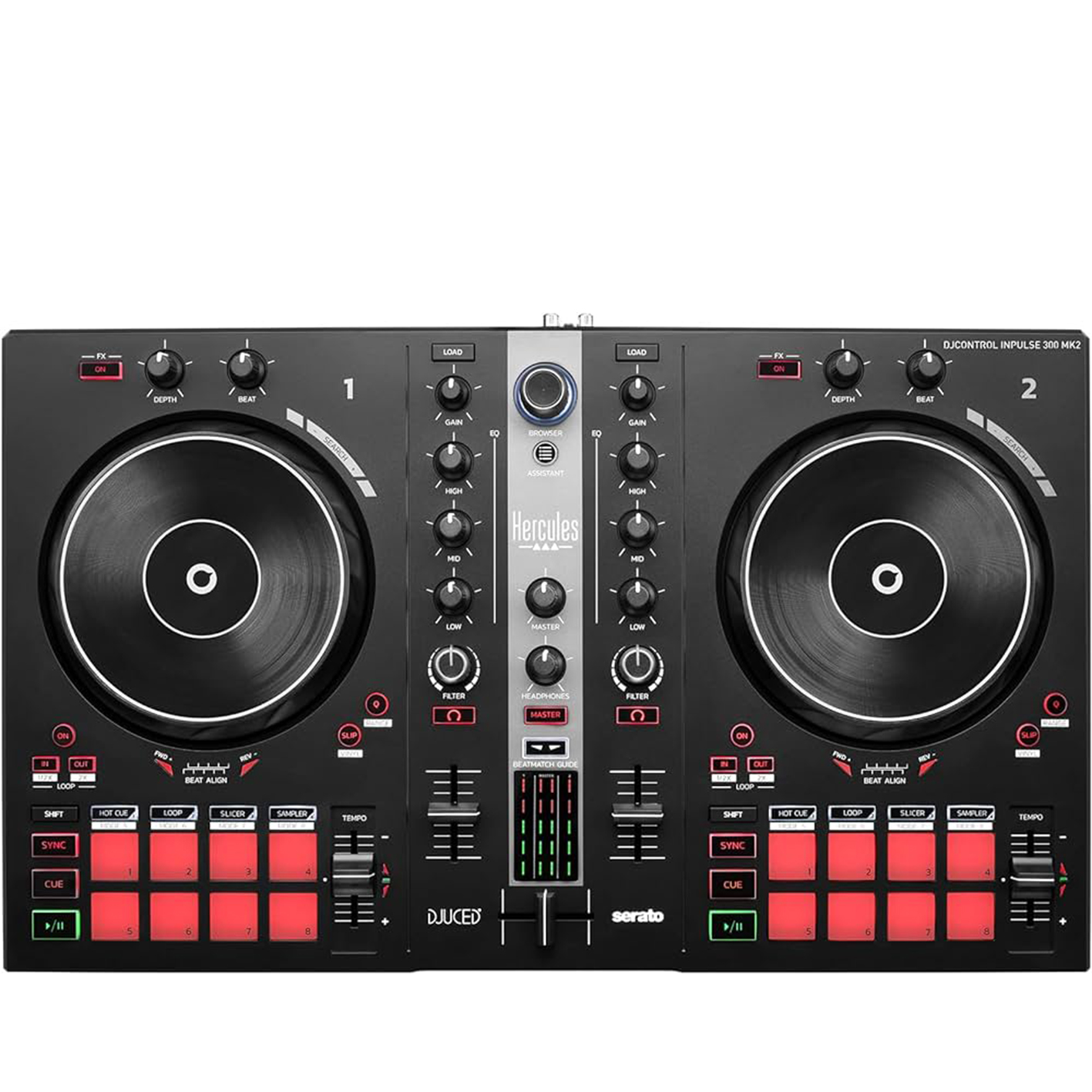
Hercules’ Inpulse range is aimed squarely at beginner DJs. Not only are they affordable and easy-to-use, but they’re specifically set up to teach you how to mix. The controllers come supplied with Hercules’ own DJUCED software, which makes use of integrated video tutorials and a light guide on the controller itself to demonstrate what-does-what.
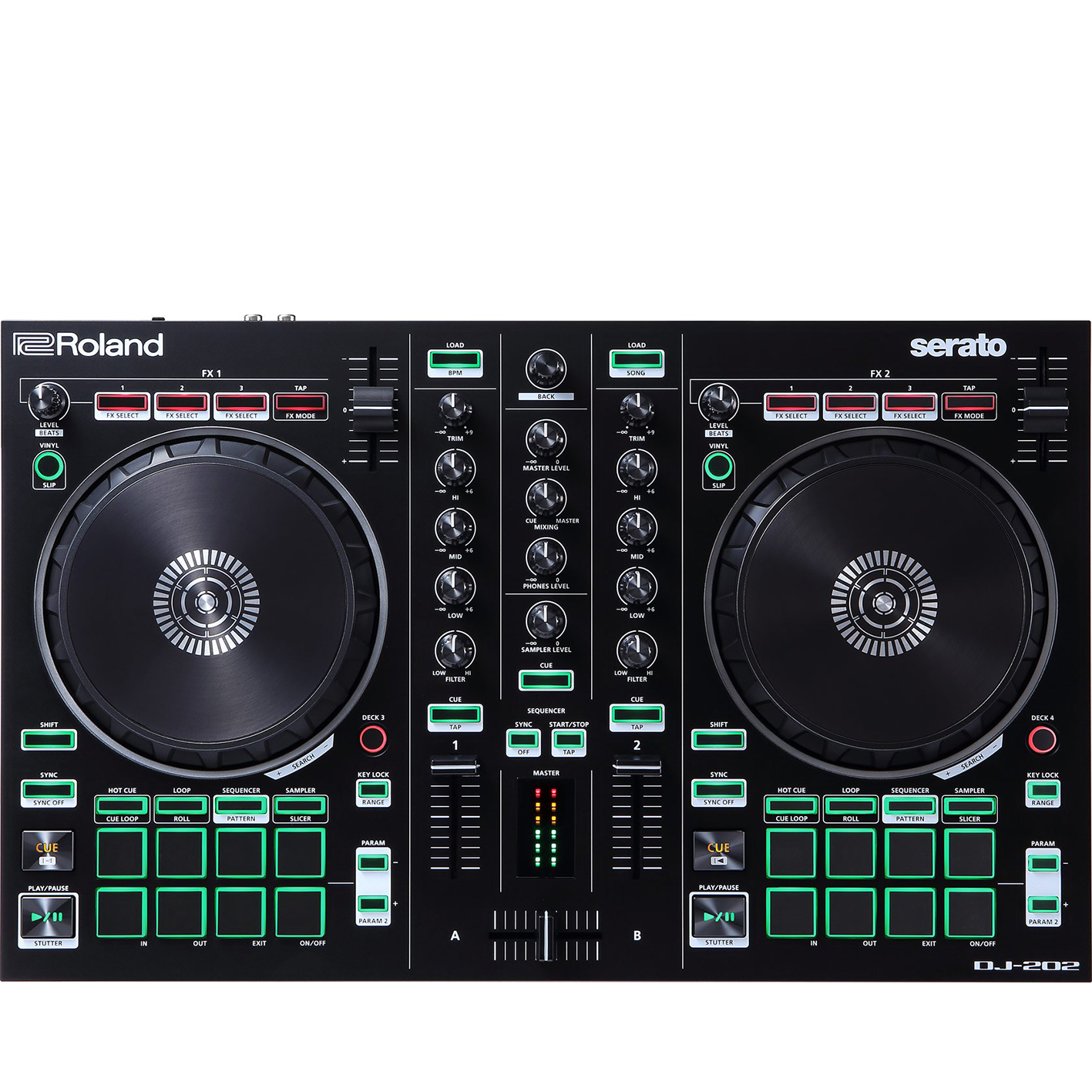
Roland is a relative newcomer to the DJ gear realm, but its range of controllers has a great USP – packing emulations of the brand’s iconic 808, 909 and 707 drum machines into the controller itself. The well-sized performance pads are still more than enough to allow users to jam-out drum patterns on the fly, mid-mix.
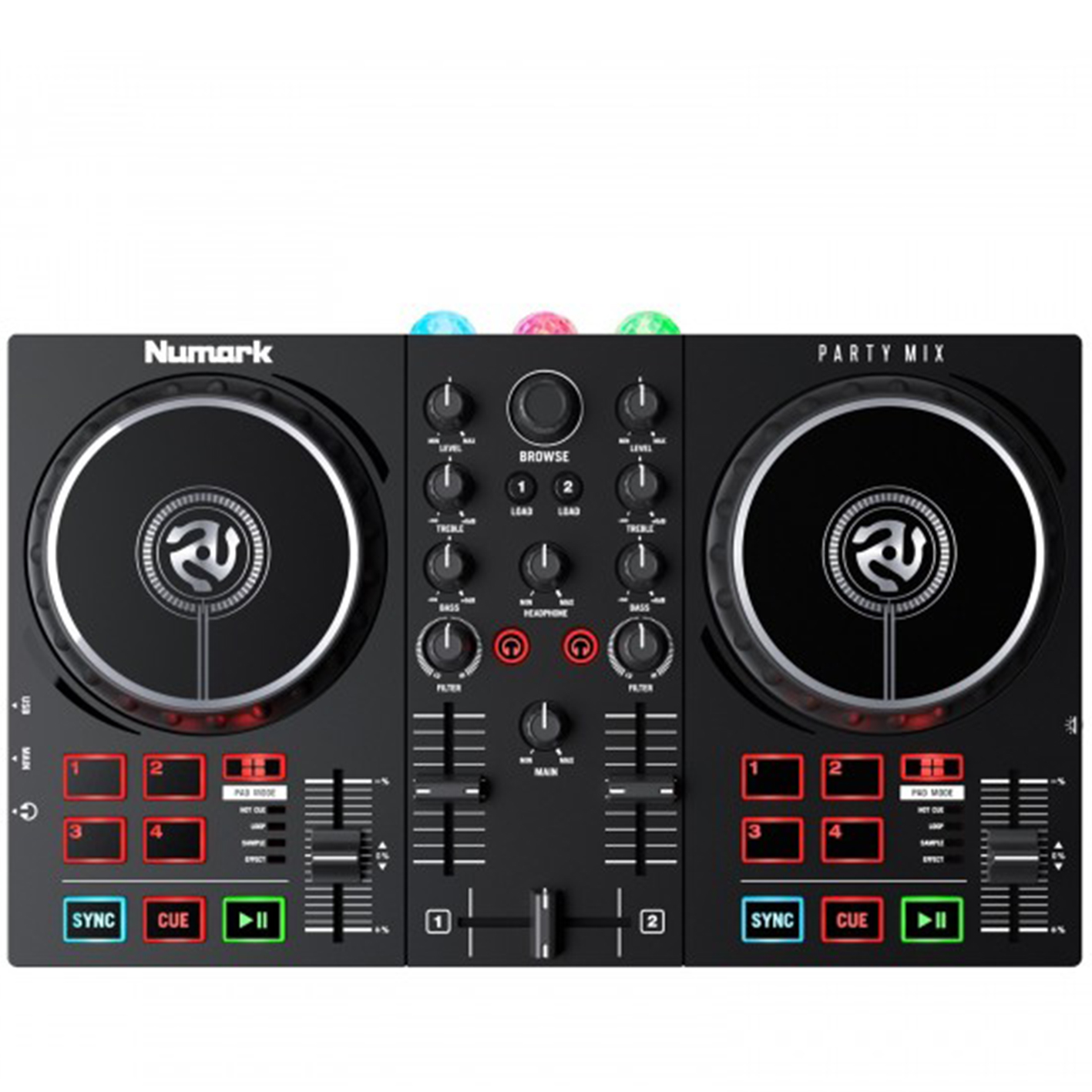
Somewhat gimmicky and toy-ish, but pleasingly affordable and fun nonetheless. The Party Mix boasts a decent crop of features for its price, including two jog wheels, faders, EQ controls and performance pads for each deck. This version 2 update has recently added more pro-level features including significantly improved jog wheels and per-track filter controls.
Best overall
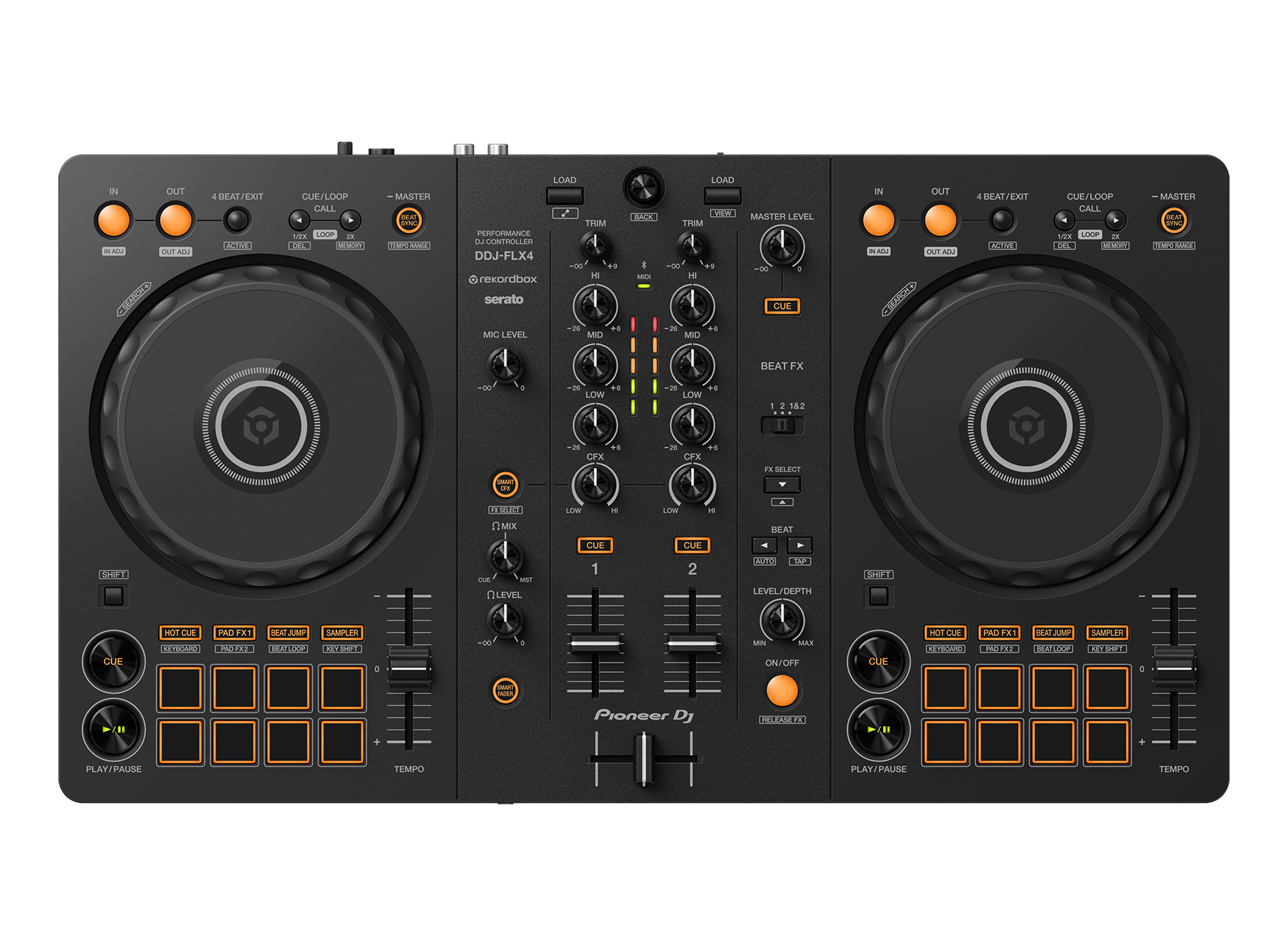
Specifications
Reasons to buy
Reasons to avoid
✅ Buy if you want the best of everything: From pro features and Bluetooth connectivity, to beginner-frindly tools, there's no better model for noobs on the market right now.
❌ Avoid if you're taking it on the road: It's not the most robustly built controller in this guide.
Pioneer’s CDJs are essentially the industry standard - at least for club DJs - and their extensive range of mid and pro-grade DJ controllers rarely fail to hit the mark. The 2-channel DDJ-FLX4, replacing the popular DDJ-400, offers a simplified take on these high-end options that delivers the essentials - jog wheels, performance pads and a simple mixer - without threatening to overwhelm beginner DJs with too steep a learning curve.
The FLX4 is built to work with both the included Serato DJ Lite and rekordbox, Pioneer’s flagship piece of DJ software. This brings with it access to sophisticated performance features and lets you hook up the USB bus-powered controller via Bluetooth to a smartphone or tablet running rekordbox’s mobile app; meaning you can spin an entire set wirelessly and without a laptop in sight, streaming tracks directly from Beatport, Beatsource, Soundcloud or TIDAL.
The DDJ-FLX4 was designed with beginners in mind, from the easily accessible layout right down to the brand new Smart Mixing features that simplify the process of beatmatching, EQing and effects processing to make mixing a breeze. The Smart Fader automatically tweaks volume, EQ and BPM to help create smooth transitions between your tracks, while Smart CFX instantly applies a selection of multi-effects to help emphasize climactic moments in your sets.
All in all, Pioneer’s DDJ-FLX4 is one of the most versatile beginner DJ controllers on the market, offering more than enough in terms of hardware specs and software compatibility to help novices to develop their skills on the decks and perform confidently.
Read our full Pioneer DJ DDJ-FLX4 review
Best budget DJ controller
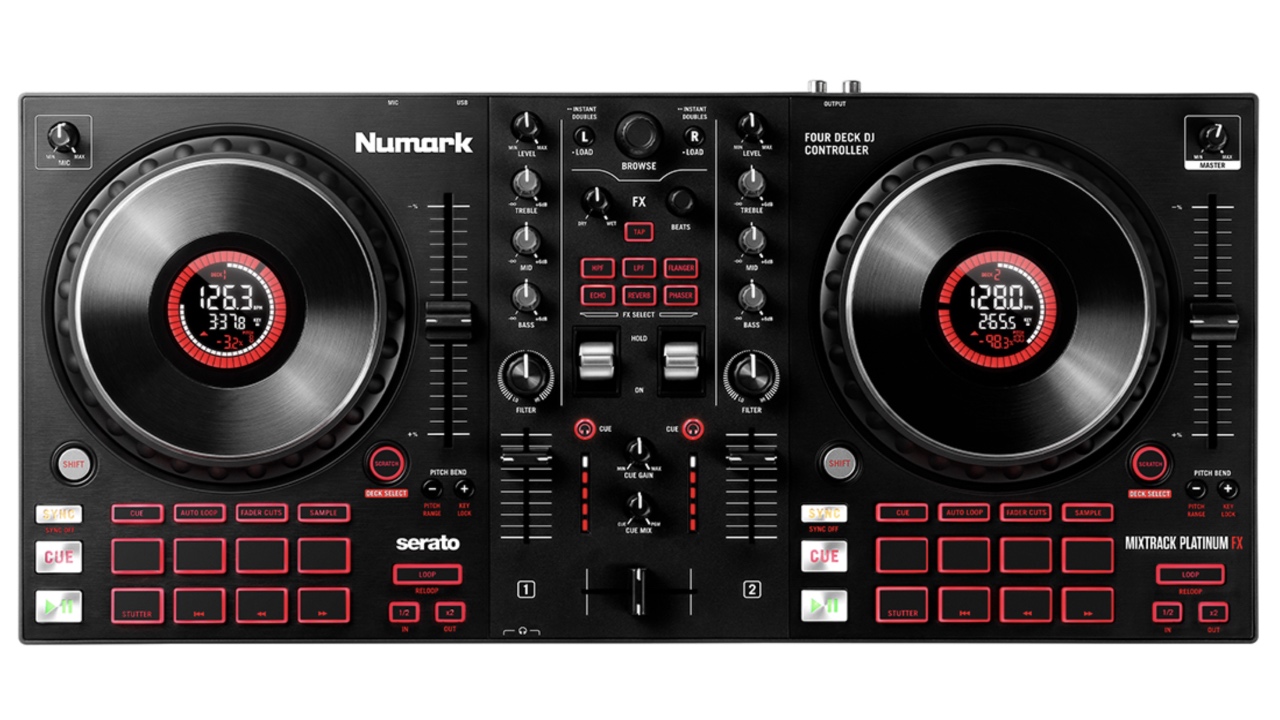
2. Numark Mixtrack Platinum FX
Our expert review:
Specifications
Reasons to buy
Reasons to avoid
✅ Buy if you want a great value controller: For a bang-for-you-buck, budget-friendly controller, look no further.
❌ Avoid if you're on a super tight budget: This isn't actually the cheapest controller in this guide, but we feel it's the one that offers the most for the money.
Numark’s Mixtrack range is one of the more longstanding names in entry-level DJing and has always brought a great balance of features for a low price. Its latest addition, the Platinum FX, might be the best value yet when it comes to bang-for-your-buck.
The Platinum FX is the top end Mixtrack controller, meaning it boasts pro features such as 4-deck mixing, sizeable jog wheels with hi-res displays and a mic input. The FX part of the name signifies the inclusion of a range of cool performance/remix tools such as Hot Cues, Auto Loop, Sampling and Fader Cuts. There’s also a pair of neat paddle switches designed for quickly accessing Serato’s built-in effects. It all adds up to a lot of potential fun, making seemingly advanced DJ tricks easy to achieve.
While the top-end Platinum FX is probably the best value, if you can live without 4-deck mixing and the jog wheel displays, the Mixtrack Pro FX packs many of the same features for around $/£50 cheaper than the Platinum.
Best for total beginners
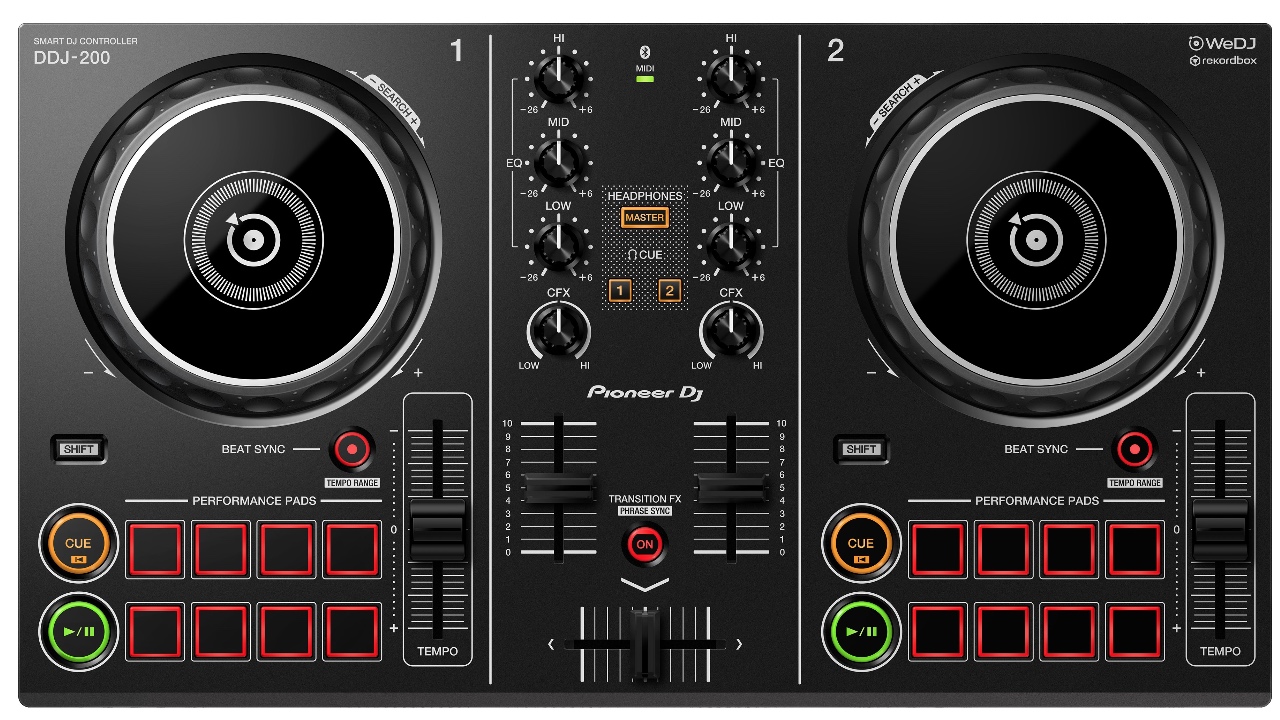
3. Pioneer DJ DDJ-200
Our expert review:
Specifications
Reasons to buy
Reasons to avoid
✅ Buy if you want a helping hand with your mixing: The accompanying WeDJ app will guide you through your first mixes.
❌ Avoid if you want an audio interface built-in: No interface will limit how you can use this controller, but that's why it's so cheap.
A smaller sibling to the DDJ-400, the DDJ-200 can be used with Algoriddim Djay, edjing Mix or Pioneer’s own rekordbox and WeDJ applications. The latter of these is an iOS/Android app with some great tutorial features aimed at getting newbies up to speed with the basics of DJing.
The ability to step up to the more pro-featured rekordbox software offers a nice route into advanced mixing too. That said, although DDJ-200 users can still unlock some of rekordbox’s advanced performance features, there’s less in the way of hardware control when it comes to things like looping, sampling or effects.
The DDJ-200 is Bluetooth-equipped to connect to mobile devices or laptops wirelessly, and its power demands are low enough for it to happily run off a portable USB charger. The WeDJ app allows users to mix with tracks from SoundCloud Go+ or Beatport LINK too – although separate subscriptions to these services are required.
The notable downside here is the lack of an audio interface, meaning you’ll need a separate device for a proper master out/headphones DJ set-up – which is reflected in the low price. There is a split audio cable included in the box though, which allows for a rudimentary workaround in order to monitor tracks.
Best for scratching
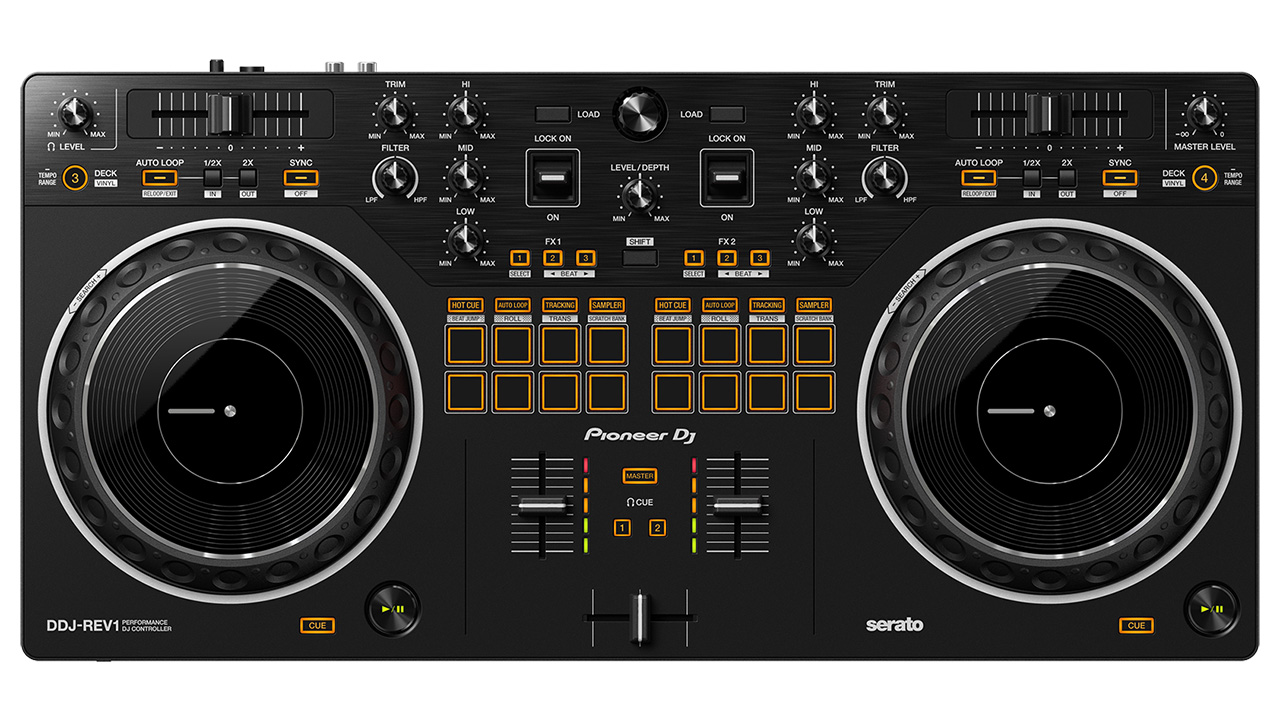
4. Pioneer DJ DDJ-Rev 1
Our expert review:
Specifications
Reasons to buy
Reasons to avoid
✅ Buy if you want killer jog wheels: The larger jog wheels in evidence here make this an ideal entry-level controller for budding scratchers.
❌ Avoid if you want Serato Pro: This one only comes with Serato Lite; you'll need to pay to upgrade to Pro.
On the whole, scratch DJs and turntablists are fairly poorly served by entry-level DJ gear, which often features cheap crossfaders and small, unresponsive jogwheels. This affordable entry into Pioneer’s new DDJ Rev range aims to address that.
The REV-1 works with the free Serato DJ Lite. Its mixer section is based on the design of Pioneer’s higher-end DJM-S, flanked by jog wheels based around the brand’s PLX turntables. The Rev 1 is positioned in a ‘battle’ layout – meaning the tempo sliders are positioned above, rather than alongside the jogwheels, which is a set-up generally favoured for scratching and rarely seen on beginner gear.
The Rev 1 also features jogs that are noticeably larger than most other entry-level controllers, which is another factor that should aid those trying to develop their scratch skills. Other key features include an array of performance pads – these can be used for sampling and cue point tricks – and a mic input to suit budding streamers.
Best for Traktor
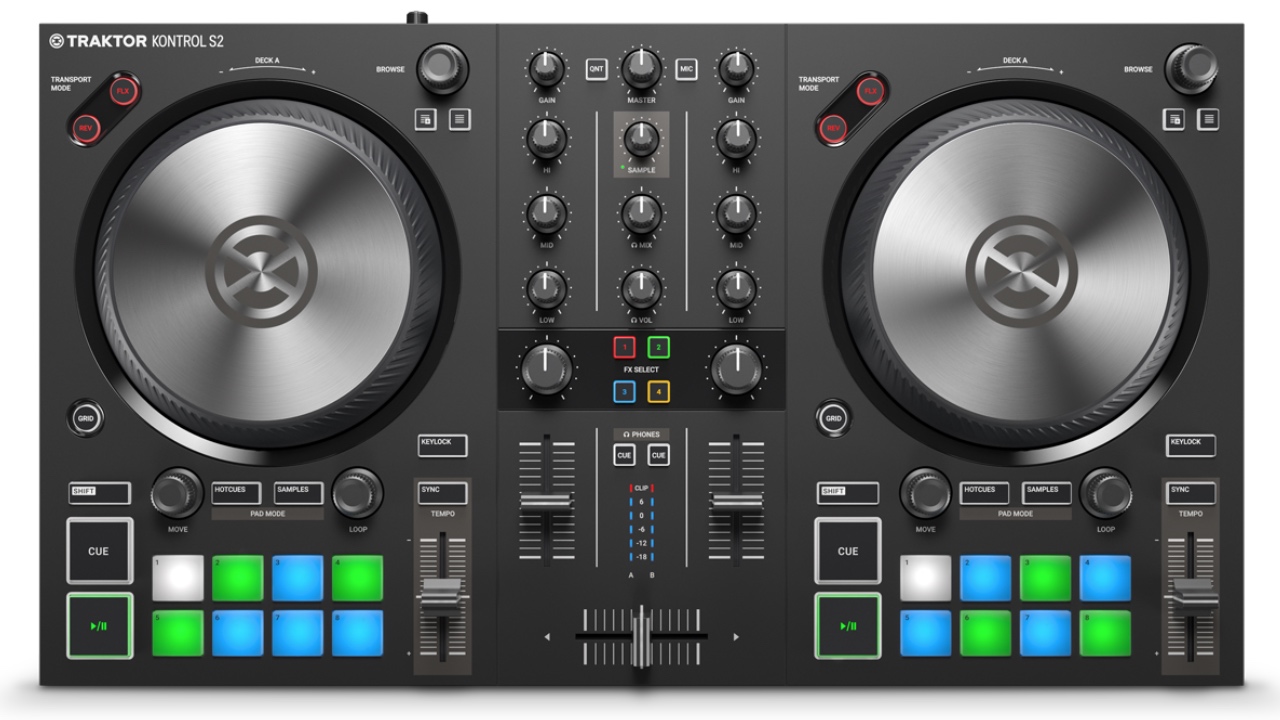
5. Native Instruments Traktor Kontrol S2 Mk3
Our expert review:
Specifications
Reasons to buy
Reasons to avoid
✅ Buy if you want to get stuck into Traktor Pro: The Traktor Kontrol S2 Mk3 comes bundled with a full Traktor Pro license.
❌ Avoid if you want to control more than 2 decks: If two decks is your bag then fine, but there's no futureproofing here if you want to expand at a later date.
Now in its third generation, NI’s entry-level Traktor controller is one of the most stylish-looking devices you’ll find at this end of the market. It’s sturdily built too, and certainly feels more ‘pro’ than its price point suggests.
The S2 is a controller specifically intended for Native Instruments’ own Traktor ecosystem. It’s designed to work with both the cross-platform, beginner-friendly Traktor DJ app, and the more fully-featured Traktor Pro 3 – and the fact that it ships with a full license for the latter of these is a major selling point.
While the S2 lacks the more complex effect and sampling controls of bigger Traktor controllers, there’s still plenty here for beginners and experienced DJs alike to get their teeth into. It’s far from the cheapest beginner controller out there, but the S2 is likely to satisfy improving DJs even as their needs and ambitions grow.
Read the full Native Instruments Traktor Kontrol S2 Mk3 review
Best compact model
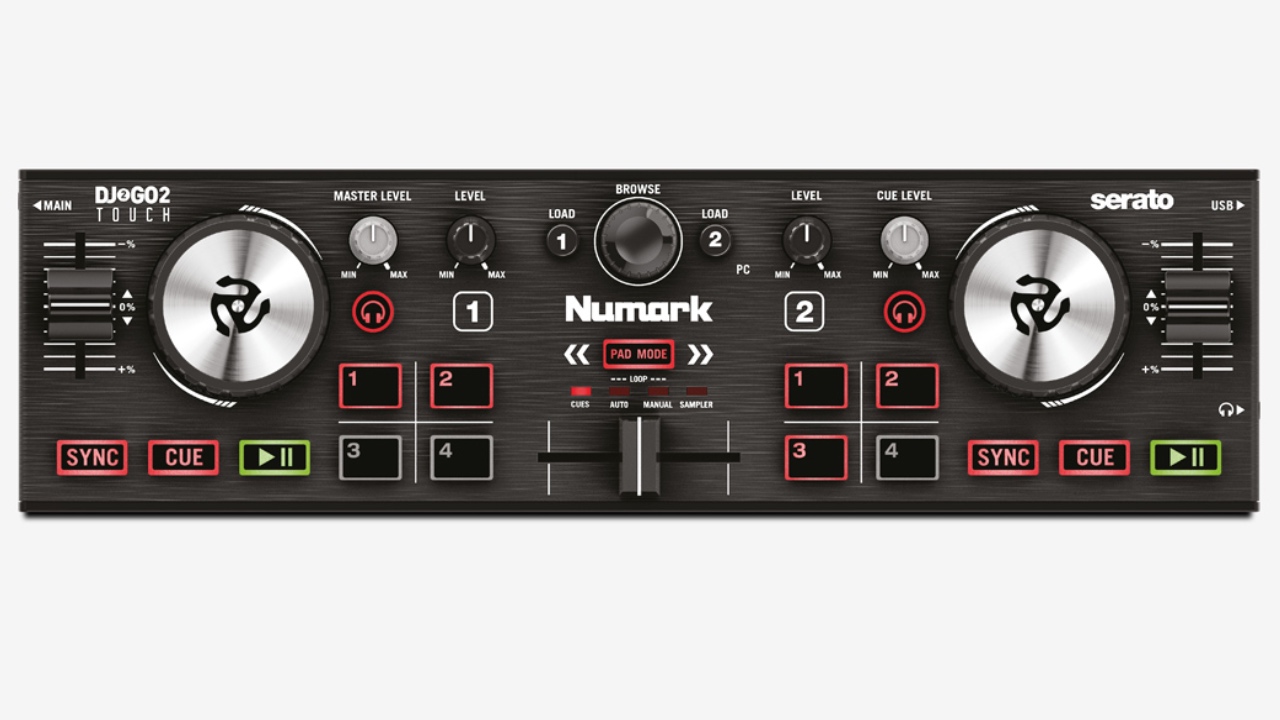
6. Numark DJ2GO2
Our expert review:
Specifications
Reasons to buy
Reasons to avoid
✅ Buy if you want a controller to throw and go: The dimensions of the DJ2GO2 make it the ideal option to DJ anywhere. Chuck in a bag, leave the house and the world becomes your DJ booth.
❌ Avoid if you want a full-size controller: The compact size is great for some, but could prove fiddly if it's your main device.
In terms of balancing size and features, Numark’s updated DJ2GO is one of the most jam-packed DJ controllers on the market. Its slim form factor could, just about, legitimately be called pocket-sized, but the device still finds space for two jog wheels, a crossfader, built-in interface and four performance pads for each deck.
Numark claims the DJ2GO2’s touch-capacitive jog wheels are capable of handling scratching duties, which is technically true, although their compact size means they’re too fiddly for moves with any real finesse. Still, there’s plenty of fun to be had here.
The controller is designed for use right-out-the-box with the free Serato DJ Lite, but it’s mapped and ready for use with the full paid version – as well as other software – if and when you’re ready to upgrade.
Best for Serato
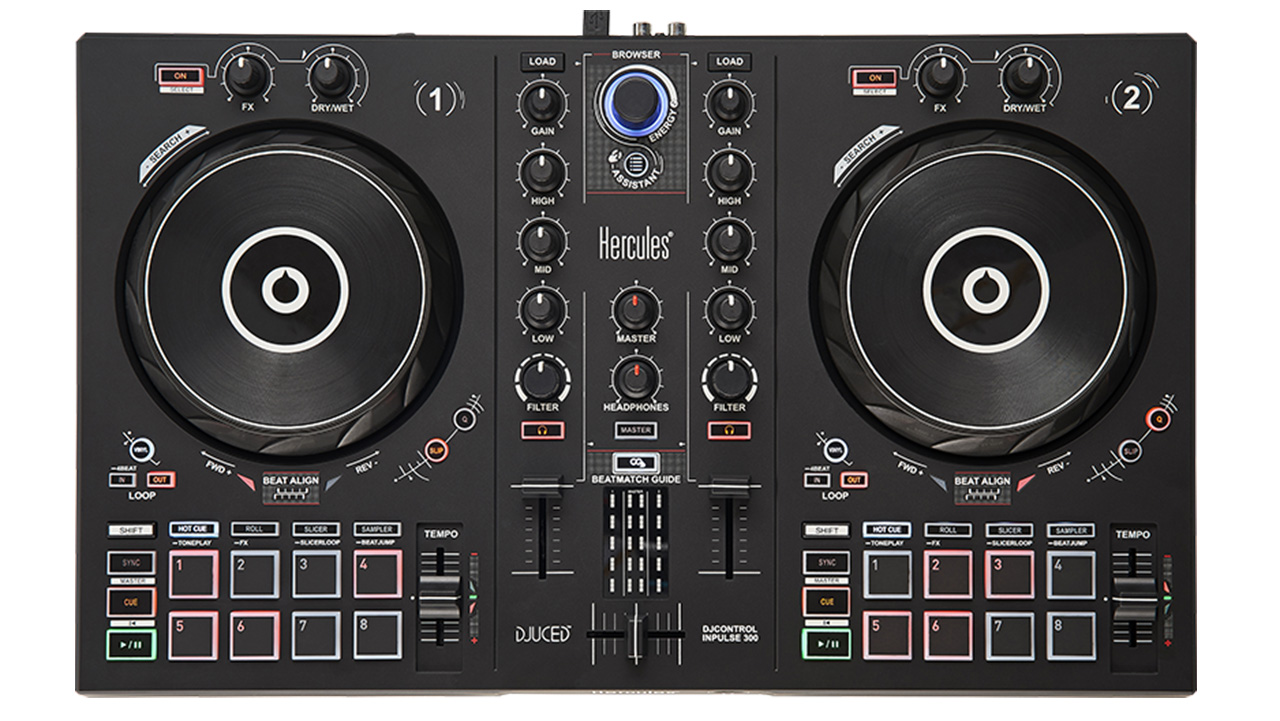
7. Hercules DJ Control Inpulse 300 Mk2
Our expert review:
Specifications
Reasons to buy
Reasons to avoid
✅ Buy if you want to get stuck into Serato: This controller is an excellent jumping off point for working with Serato.
❌ Avoid if looks are important to you: It's not the best-looking controller available today, so shop elsewhere if you need style as well as substance.
Hercules’ Inpulse range is aimed squarely at beginner DJs. Not only are they affordable and easy-to-use, but they’re specifically set up to teach you how to mix.
The controllers come supplied with Hercules’ own DJUCED software, which makes use of integrated video tutorials and a light guide on the controller itself to demonstrate what-does-what. These tools are coupled with visual ‘beat align’ guides to help visualise the sync of your two decks, along with an ‘Intelligent Music Assistant’ tool, which will automatically suggest the next track to keep your mix going.
The 300 is the highlight of the range, largely because – as of a recent update – it offers integration with Serato DJ. As a result, there’s an obvious route of progression for beginner DJs, who might want to transition to Serato’s pro-level software as they get to grips with the basics of mixing.
The hardware itself still looks a little toy-like, and the short faders don’t allow for much in the way of nuanced mixing, but there’s a decent amount of functionality here for the money.
Best 4 channel
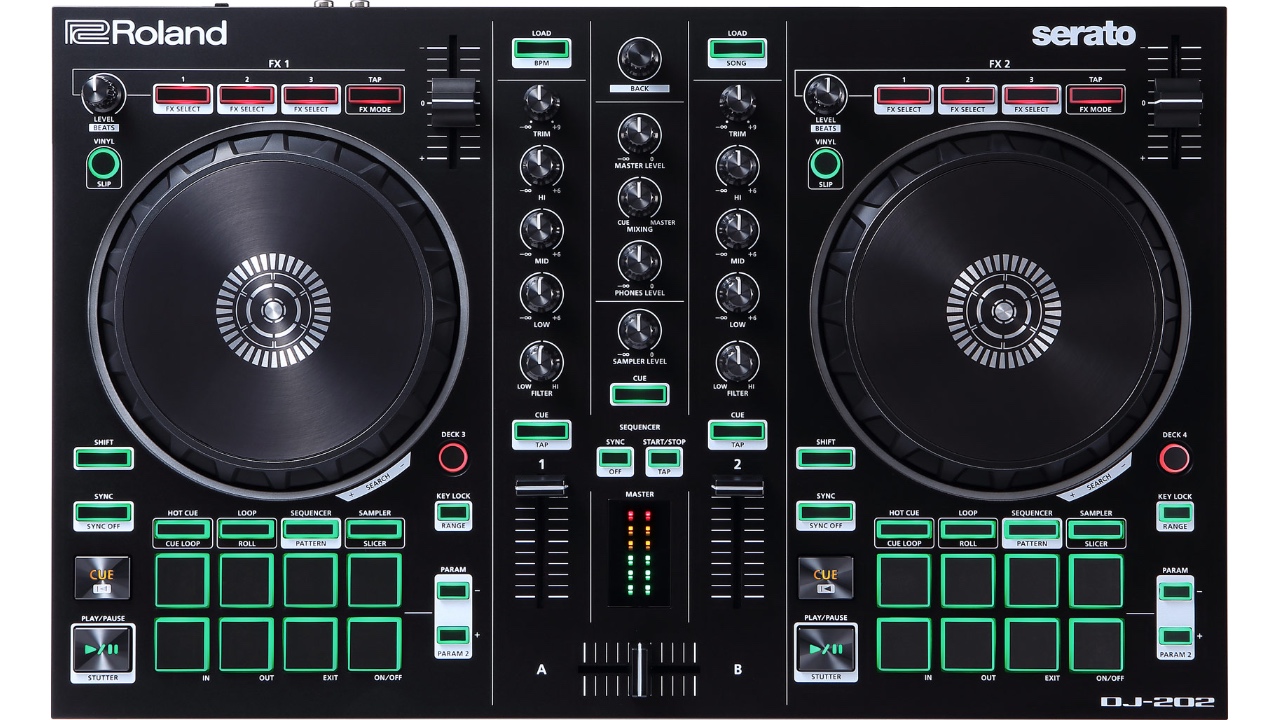
8. Roland DJ-202
Our expert review:
Specifications
Reasons to buy
Reasons to avoid
✅ Buy if you want the option to control 4 decks: Many of the controllers in this guide only have the option for 2 deck control. This gives you double the flexibility.
❌ Avoid if you want a no-frills controller: Added extras such as vocal effects and drum machine also add to the cost.
Roland is a relative newcomer to the DJ gear realm, but its range of controllers has a great USP – packing emulations of the brand’s iconic 808, 909 and 707 drum machines into the controller itself.
There are fewer controls here than on the higher-end DJ-505 and DJ-808 controllers, meaning that sequencing those drum sounds is a little more fiddly. That said, the well-sized performance pads are still more than enough to allow users to jam-out drum patterns on the fly, mid-mix.
The DJ-202 also includes a mic input and several onboard vocal effects, including a gate, filters, reverb and echo.
Software-wise, the DJ-202 is designed for use with Serato Lite (included), but if you own or purchase a Serato Pro license, the 202 is fully mapped to make use of the software’s more pro-level features. You’re paying for those quality drum sounds and vocal effects here, so if those appeal then this is a decent value package, otherwise you may get more for your money elsewhere.
Best for parties
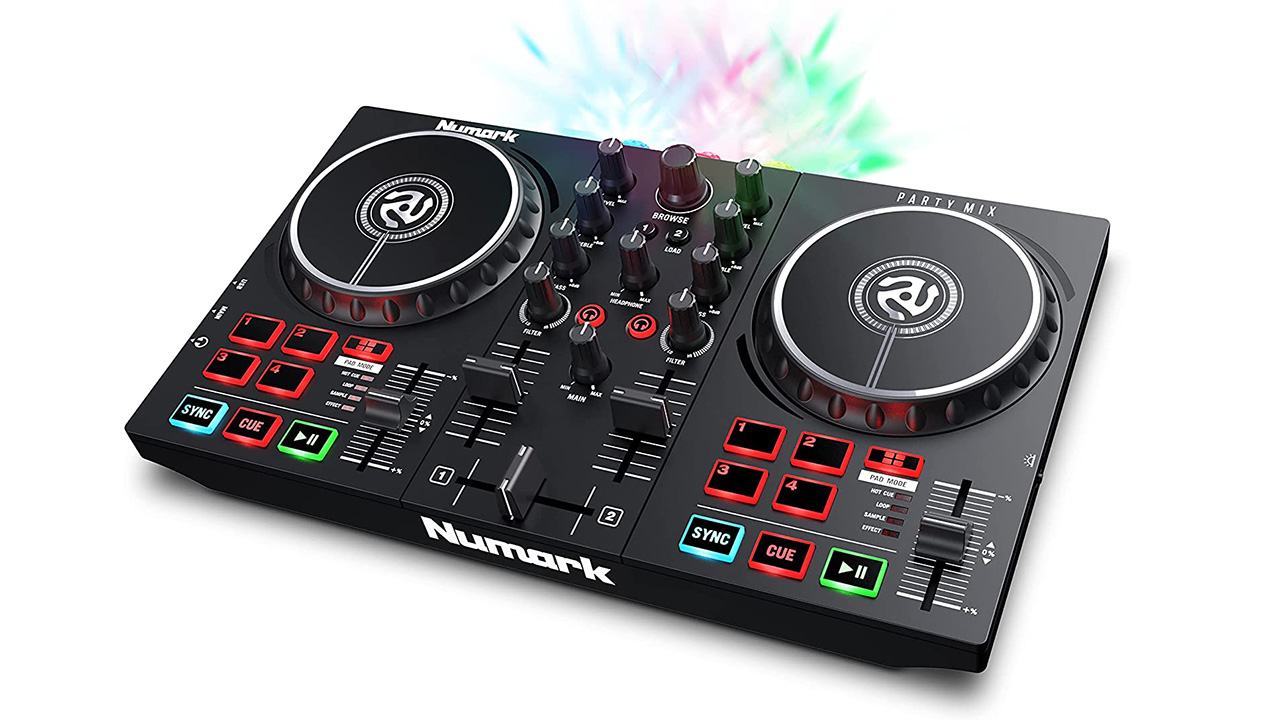
9. Numark Party Mix II
Our expert review:
Specifications
Reasons to buy
Reasons to avoid
✅ Buy if you regularly throw, or go-to, house parties: It's easy enough for anyone to use and has a built-in light show!
❌ Avoid if you want a serious controller: While this does the job it's intended for, this isn't one for a pro DJ booth.
Somewhat gimmicky and toy-ish, but pleasingly affordable and fun nonetheless, the USP of Numark’s Party Mix lies in the trio of LEDs along its front edge. These provide what Numark calls a ‘built-in light show’. This is perhaps overselling it a bit – really it’s three coloured lights flashing in sync with the tempo of your tracks; a neat little effect but with little variation and not enough presence to make a difference in any setting larger than a small house party.
Cynicism aside though, the Party Mix boasts a decent crop of features for its price, including two jog wheels, faders, EQ controls and performance pads for each deck. This version 2 update has recently improved things further too, adding more pro-level features including significantly improved jog wheels and per-track filter controls.
As well as the standard Party Mix model, Numark also offers a Party Mix Live device that adds built-in speakers to the mix. You can turn the lights off when desired too.
Buying advice

All the jargon and differing specifications of the many different beginner DJ controllers can be a little overwhelming for the uninitiated, so here’s a guide to a few basic terms to look out for.
What are jog wheels?
These are the main circular platters seen on all the products we’ve covered in this guide. Jog wheels replicate the look and function of traditional vinyl turntables, allowing DJs to scroll through tracks, scratch, and ‘nudge’ the timing of a track backwards or forwards.
If you plan on traditional beat-matching - ie. syncing up the timing of two records by ear - or hip-hop style turntablism and record scratching, then jog wheels are a must, and they’re also used for things like searching through a track and setting cue points. And while most DJ software now comes with automatic beat-matching capabilities, meaning that you might not actually need to use the jog wheels, most DJs still use them in some way, even if it’s just to perform a re-load.
What are faders/crossfaders?
All DJ setups have two main sections: the players - and they can be vinyl decks, digital decks or the jog wheel section of a controller - and the mixer, which houses the controls the DJ uses to blend and mix songs.
Faders are the controls on the mixer that you use to ‘fade’ between different songs. Most DJ controllers have faders in some form, although smaller devices may opt for a simple volume knob instead. They’re usually vertical channel controls, which you move up to increase the volume and down to decrease the volume of an individual track.
A crossfader is a horizontal fader that blends two songs together. As you move the crossfader from one side to the other, the volume of one song gradually fades out, and the volume of the incoming song increases. You can also use the crossfader to switch quickly between tracks, and it’s the central tool for scratching, too.
Can you tell me more about the audio interface?
An audio interface is the part of your setup that controls how sound comes in and out of your computer. Most computers come with some kind of internal audio interface while many people choose to use external devices, depending on their requirements. Some DJ controllers double up as an audio interface - like an external sound card - and will have an audio output that can be connected to speakers or a PA system. This is likely to provide a better quality audio signal than using your laptop’s onboard audio, especially if you’re playing at a party, event or in a club/bar.
In most cases, audio interfaces will also include a headphone output which enables the DJ to monitor tracks, which means they can preview a song without it being heard through the main output. This is an essential part of a DJ set up so unless you’re already using a separate audio interface, you’ll need a controller with these capabilities.
Controllers with inbuilt interfaces may offer additional inputs and outputs too, such as a secondary ‘booth’ output (for a separate speaker for the DJ booth), or an input for a vocal microphone or external sound source, allowing you to also play a turntable, MP3 player or synth/drum machine through your controller.
What about DJ controller software?
To DJ using a controller you need a laptop, a controller and DJ software. The controller, as the name suggests, controls the software which allows you to mix your music together. None of these controllers can be used standalone, they all need to run in tandem with a piece of software and laptop.
Most controllers come bundled with a DJing software license or free download. Some controllers are designed to work with multiple applications, while others are limited to use with just one specific piece of software, so your choice of controller is also going to be a choice of DJ software too.
For help deciding which is right for you, check out our handy guide to the best DJ software applications.
What are common features in DJ controllers?
Along with volume faders, most DJ controllers will include EQ controls and often filters, too.
EQ is usually the next tool DJs learn after basic volume blending. The EQ controls allow the
DJ to cut or boost separate parts of the frequency spectrum - the bass, mids and highs - and is a super-useful mixing tool for DJs. Filters can perform a similar but more extreme role and there are lots of DJ tricks and techniques involving EQ and filters - see our 5 essential EQ & filter tricks for DJs feature.
Most modern controllers also include some form of ‘performance pads’ for each deck. These can fulfil a variety of roles, from jumping to different ‘cue points’ within a track to triggering loops, samples and effects. While pads aren’t essential for mixing tracks by any means, they’re a fun and creative tool to have in your DJing arsenal.
How we choose products for this guide
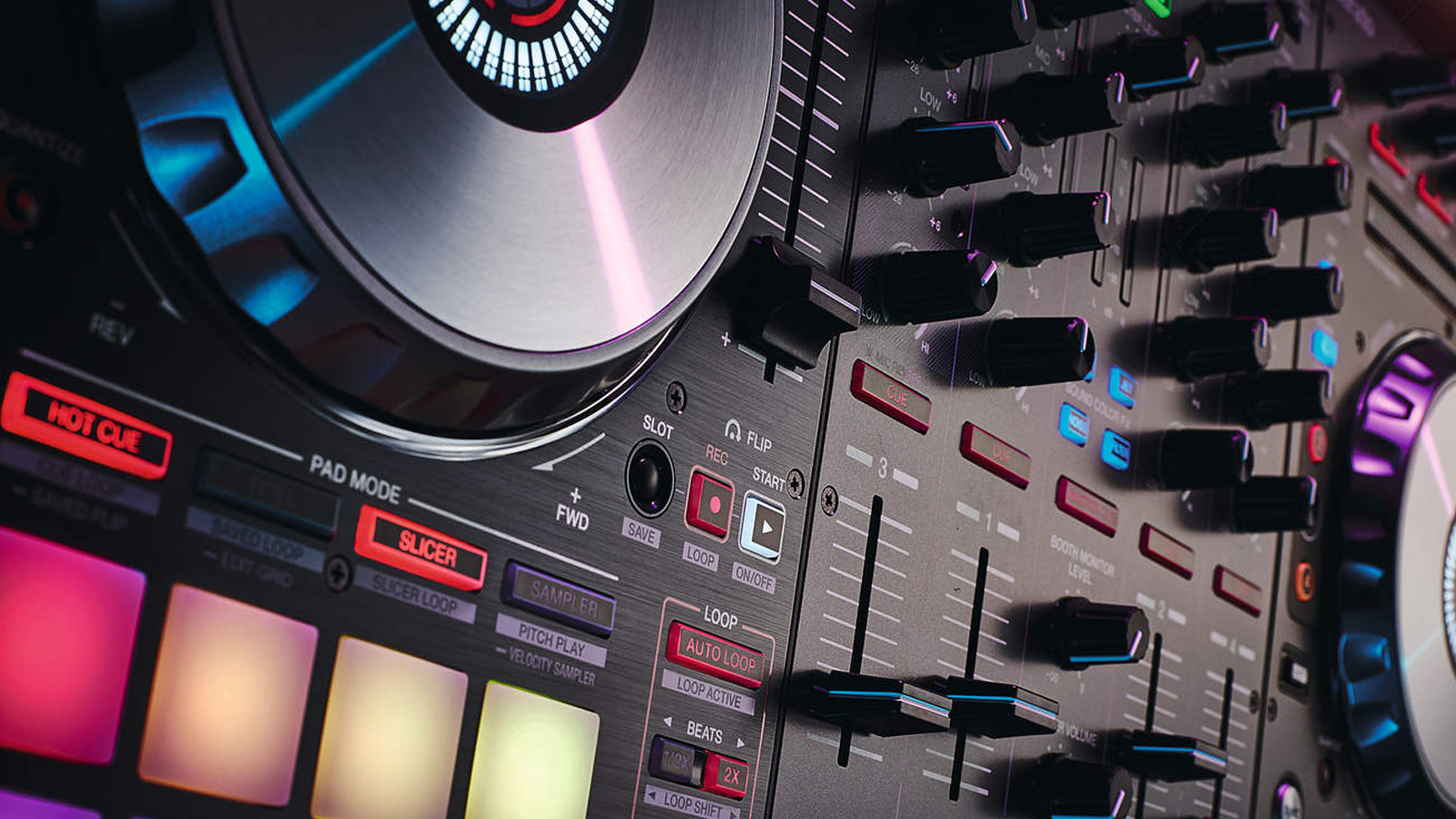
Here at MusicRadar, we are experts in our field, with many years of playing, creating and product testing between us. We live and breathe everything music gear related, and we draw on this knowledge and experience of using products in live, recording and rehearsal scenarios when selecting the products for our guides.
When choosing what we believe to be the best beginner DJ controllers available right now, we combine our hands-on experience, user reviews and testimonies and engage in lengthy discussions with our editorial colleagues to reach a consensus about the top products in any given category.
First and foremost, we are musicians, and we want other players to find the right product for them. So we take into careful consideration everything from budget to feature set, ease of use and durability to come up with a list of what we can safely say are the best beginner DJ controllers on the market right now.
Find out more about how we test music gear and services at MusicRadar.
Why you can trust us
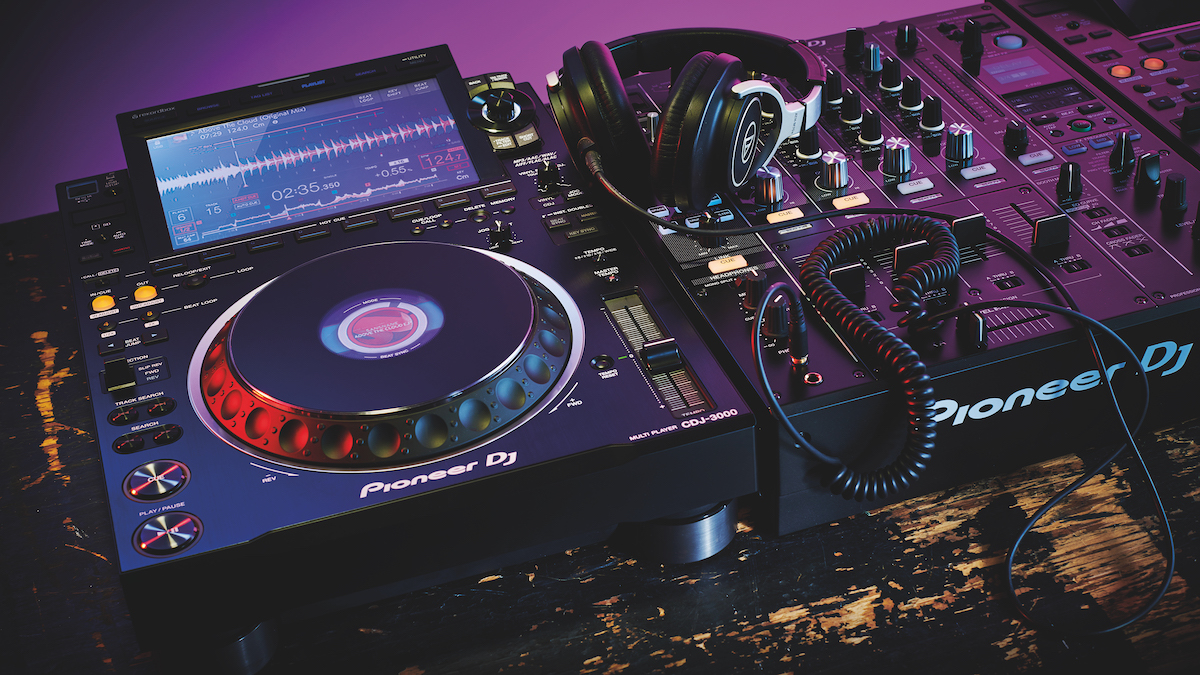
✔️More than 9,500 reviews on-site
✔️Over 17 years of product testing
✔️ 2.9 million monthly users globally
With more than 17 years of experience, MusicRadar is the premier music-making website in the world. Run by musicians for musicians, we offer expertly written gear round-ups and high-quality, authoritative reviews by an extensive team of highly experienced industry professionals.
We also interview world-renowned musicians and stars about their creative processes and the nuts and bolts of their gear and technique. This gives fans an insight into the actual craft of music-making that no other music website can.
But that's not all. We also provide excellent tuition, from bite-sized tips to advanced techniques and guidance from recognised musicians.
As well as delivering high quality written reviews and features, we also produce a wealth of video content on YouTube. MusicRadarTV is where you'll find all of our access-all-areas interviews, hot gear demos and exclusive video lessons.
Below you'll find more information on the authors of this guide.

I'm the Managing Editor of Music Technology at MusicRadar and former Editor-in-Chief of Future Music, Computer Music and Electronic Musician. I've been messing around with music tech in various forms for over two decades. I've also spent the last 10 years forgetting how to play guitar. Find me in the chillout room at raves complaining that it's past my bedtime.

Harold Heath is a UK music writer and author. A DJ since the late 80s, Harold also produced a few hundred singles and remixes and two artist albums, and worked as a performer, ghostwriter and music-technology teacher. His first book Long Relationships: My Incredible Journey From Unknown DJ to Smalltime DJ was published in 2021.

I'm MusicRadar's Tech Editor, working across everything from product news and gear-focused features to artist interviews and tech tutorials. I love electronic music and I'm perpetually fascinated by the tools we use to make it. When I'm not behind my laptop keyboard, you'll probably find me behind a MIDI keyboard, carefully crafting the beginnings of another project that I'll ultimately abandon to the creative graveyard that is my overstuffed hard drive.
Related buyer's guides
MusicRadar's got your back
- Check out the best beginner DJ mixers
- Our pick of the best DJ headphones available today
- Essential DJ accessories for the studio to the booth
Want all the hottest music and gear news, reviews, deals, features and more, direct to your inbox? Sign up here.
I'm the Managing Editor of Music Technology at MusicRadar and former Editor-in-Chief of Future Music, Computer Music and Electronic Musician. I've been messing around with music tech in various forms for over two decades. I've also spent the last 10 years forgetting how to play guitar. Find me in the chillout room at raves complaining that it's past my bedtime.
- Matt MullenTech Editor
- Harold Heath